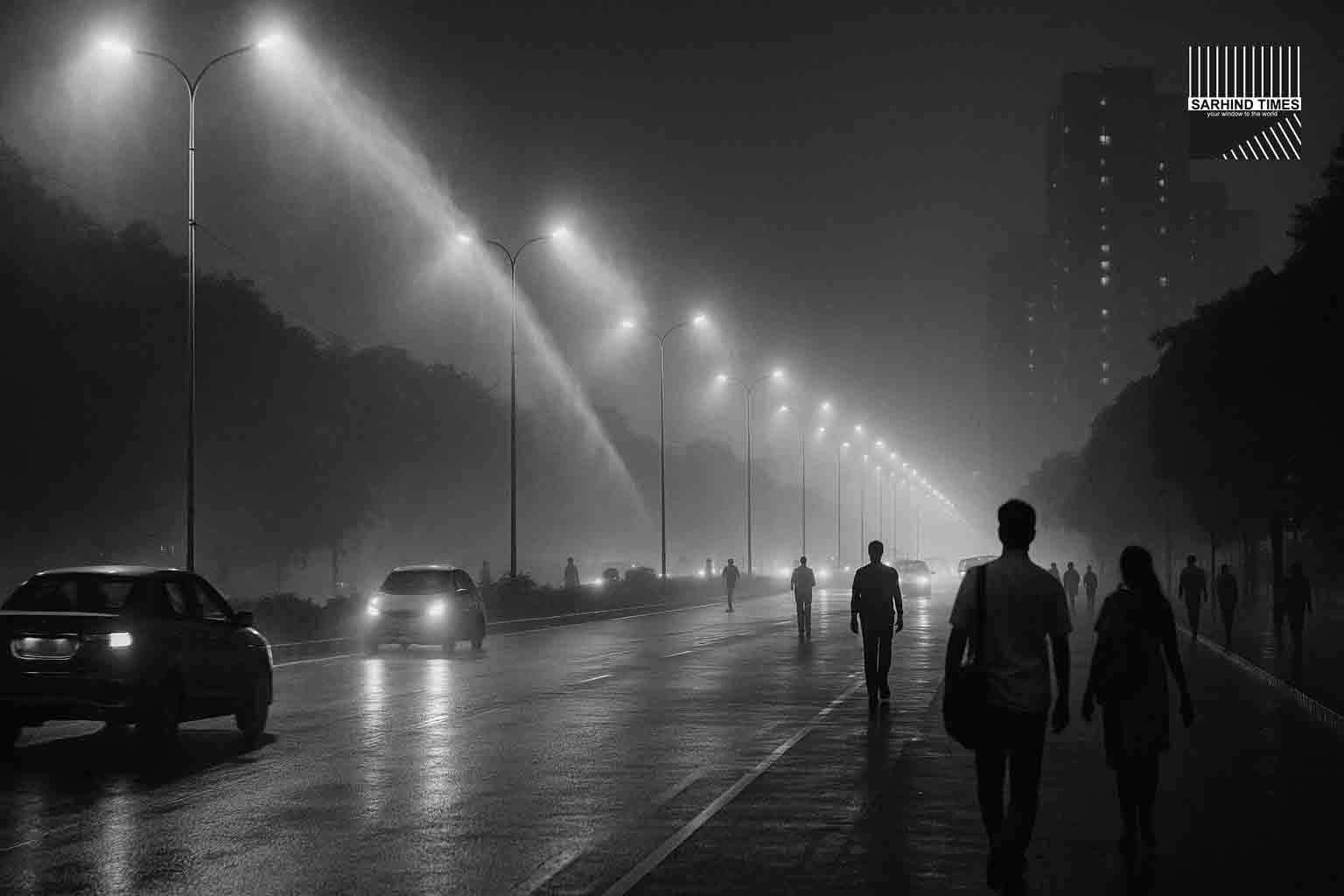The Delhi Development Authority installs RO-water mist nozzles across 166 poles over 6.8 km, marking one of India’s first continuous urban ‘anti-smog corridors’ ahead of the capital’s pollution season.
New Delhi | October 11, 2025
With the familiar haze of winter already creeping over the horizon, Delhi Development Authority (DDA) has unveiled a high-tech environmental measure — a 6.8-kilometre-long ‘anti-smog misting corridor’ in Dwarka, Sector 19, designed to suppress dust and fine particulate pollution before smog levels peak.
The system, which uses RO-treated water dispersed through high-pressure misting nozzles mounted on 166 streetlight poles, represents a proactive step by the civic body to mitigate pollution in one of the city’s busiest suburban stretches.
Officials said the setup is capable of releasing a fine mist at about 2.8 litres per hour per nozzle, creating a visible cooling and cleansing effect that helps settle dust and reduce suspended particulate matter (PM10 and PM2.5) in the air.
A Pilot That Scaled into a City Model
The corridor, inaugurated Friday, expands on a 550-metre pilot project conducted in the same area last year. After consistent readings showed localized air-quality improvement, the initiative was scaled up to connect Sector 10 through Sector 19 and stretch up to Sector 21’s traffic intersection.
“This is one of the first systematic anti-smog corridors designed for continuous street-level dust suppression,” said a senior DDA official. “The elevated nozzles improve mist reach, prevent water wastage, and help maintain consistent atmospheric moisture without causing wet patches on roads.”
The project is expected to operate automatically through IoT-based timers that activate misting cycles during high pollution hours, particularly in the early morning and evening peaks when vehicular emissions and inversions trap pollutants closer to the ground.
Inside the Technology: How the ‘Misting Corridor’ Works
Each misting unit comprises:
- Stainless steel nozzles emitting micron-sized droplets under high pressure.
- RO-treated water lines connected to underground supply points.
- Pressure pumps that maintain consistent flow.
- Timers and sensors that regulate mist duration.
Unlike water sprinkling trucks that provide short-term relief, this setup delivers continuous fine mist dispersion from elevated poles, simulating a light drizzle that binds airborne dust particles without significantly raising humidity.
“The goal is to create a microclimate of cleaner air along busy traffic corridors,” said Anuj Bhatnagar, DDA’s Environment Division head. “While it won’t transform Delhi’s AQI overnight, every gram of dust suppressed counts in the larger battle for breathable air.”
The Science Behind It: Can Misting Reduce PM Levels?
Air-quality experts acknowledge that while misting can temporarily reduce dust concentrations, its long-term efficacy depends on consistent operation, maintenance, and complementary actions.
Dr. Gufran Beig, founder of SAFAR (System of Air Quality and Weather Forecasting And Research), explained:
“Dust suppression through misting can cut coarse particulate matter locally by 10–20%, especially along arterial roads. However, secondary pollutants like ozone and fine PM2.5 require source-level control — vehicular emissions, biomass burning, and construction dust remain dominant contributors.”
The key advantage, he noted, lies in localized improvement. For cyclists, pedestrians, and roadside vendors — those most exposed to ambient air pollution — even small reductions in PM load can have measurable health benefits.
Citizens Welcome Initiative, Seek Transparency
In Dwarka, residents’ groups hailed the initiative but called for publicly available performance data.
“We appreciate the visible effort,” said Amit Gupta, president of the Dwarka Residents Federation. “But we’d like to see real-time readings from nearby AQ monitors so we can assess its impact. Pollution control must be measurable, not just visual.”
Several citizens also requested integration with Delhi’s Air Quality Monitoring Network (SAFAR/DPCC) to allow side-by-side comparisons of PM concentration before and after misting operations.
Winter Woes: A Familiar Battle
Every winter, Delhi’s air quality dips to alarming levels, often breaching the ‘Severe’ category (AQI above 400) due to stagnant winds, crop residue burning, and cold air trapping pollutants.
This year, authorities are bracing for another tough season. The Commission for Air Quality Management (CAQM) has already activated GRAP (Graded Response Action Plan) measures, including:
- Ban on construction and demolition at certain AQI thresholds.
- Mechanized road sweeping and dust suppression drives.
- Regulation of truck entry into the capital.
- Promotion of remote work and staggered office hours.
The misting corridor adds a visible and symbolic layer to this strategy — a tangible line of defense against dust pollution in densely populated residential sectors.
From Smog Towers to Misting Poles: Delhi’s Air-Tech Evolution
In recent years, Delhi has experimented with several technological tools to combat its pollution crisis.
| Year | Initiative | Objective | Outcome |
| 2021 | Smog Towers at Connaught Place & Anand Vihar | Filtration of ambient air | Limited local impact |
| 2022 | Anti-smog guns at construction sites | Targeted dust suppression | Effective when used regularly |
| 2023 | Road dust vacuum trucks | Mechanical sweeping | Improved street hygiene |
| 2024 | Pilot Misting Corridor in Dwarka | Continuous dust control | Positive localized results |
| 2025 | Full-scale Misting Corridor | Area-wide deployment | Under evaluation |
Each innovation has underscored a broader shift — from reactive firefighting to preventive urban management.
“We can’t control crop burning in Punjab, but we can clean our own backyard,” said DDA Vice-Chairman Subhasish Panda. “If every district tackles local dust effectively, we collectively reduce the pollution load before it compounds.”
Environmental Experts Caution Against Overreliance
While welcoming the initiative, environmentalists warned against treating misting as a silver bullet.
Sunita Narain, Director General of the Centre for Science and Environment (CSE), said:
“Dust control is one piece of the puzzle. Unless we address waste burning, traffic emissions, and industrial output, misting corridors will only offer temporary relief.”
CSE has recommended a comprehensive urban dust management policy, combining misting, mechanized sweeping, green buffers, and stricter building-site enforcement.
“We need a ‘Clean Construction Code’ just as we have a building code,” Narain added.
Cost and Maintenance
The DDA’s misting system cost roughly ₹5.2 crore, including installation, water treatment, and automation systems. The operational cost is estimated at ₹1.5 lakh per month, covering water filtration, pump maintenance, and energy.
RO-treated water is used to avoid scaling on nozzles, while regular pressure checks ensure uniform mist flow.
Maintenance will be carried out by a public-private consortium, with the DDA overseeing operational audits every quarter.
“Durability and consistency are key,” said a project engineer. “One clogged nozzle can disrupt pressure across an entire segment.”
Public Health Angle: Cleaner Air at Street Level
Delhi’s roadside PM concentrations are often 2–3 times higher than citywide averages due to resuspended dust.
For pedestrians, traffic police, and shopkeepers, exposure can lead to chronic respiratory conditions.
By reducing ambient dust near ground level, the misting corridor may lower acute exposure for nearly 15,000 daily commuters along the Dwarka route.
“Micro-interventions like this can have big local benefits,” said Dr. Randeep Guleria, pulmonologist and former AIIMS Director.
“Cleaner micro-environments — outside schools, hospitals, and markets — directly affect daily health outcomes.”
A Step Toward Urban Sustainability
DDA officials stressed that the misting corridor is part of a broader ‘Clean Dwarka, Green Dwarka’ initiative, which includes:
- Expansion of green belts and vertical gardens along flyovers.
- Rainwater harvesting retrofits at metro stations.
- Solar lighting for reduced grid dependence.
Dwarka’s transformation is being seen as a pilot model for low-emission urban clusters, combining infrastructure modernization with environmental design.
Voices from the Ground
Auto-rickshaw driver Sandeep Kumar said he noticed a “cooler feel” while passing under misting sections.
“It’s not just for pollution — even the temperature drops slightly. In summer, this could help with heat too.”
Local schoolchildren were seen photographing the mist plume, calling it “Delhi’s rain without clouds.”
Residents, while supportive, urged continuous evaluation to ensure the initiative remains more than a “visibility measure.”
The Policy Context: India’s Air Quality Push
The Dwarka project aligns with the National Clean Air Programme (NCAP), under which Delhi aims to reduce particulate pollution by 40% by 2026.
It also complements the city’s Electric Mobility Mission and Waste-to-Energy emission control efforts, forming part of an integrated urban sustainability roadmap.
“This shows that India’s pollution response is no longer confined to regulation but expanding into innovation,” said Dr. Jatin Mehra, air quality researcher at TERI.
“Infrastructure-led solutions like mist corridors demonstrate the state’s willingness to experiment with adaptive tools.”
Global Parallels: Learning from Other Cities
Several global cities have adopted misting and cooling corridors as part of their pollution or heat-management strategies:
- Beijing uses automated spray tunnels during dust storms.
- Seoul deploys fine-water nozzles under metro bridges.
- Dubai uses high-pressure mist cooling for heat and dust reduction.
Delhi’s corridor is unique for being citizen-facing and road-integrated, rather than industrial or isolated.
Criticism and Concerns
Not all experts are convinced.
Some environmental economists question whether water-intensive measures are sustainable amid Delhi’s groundwater stress.
“RO-water misting sounds efficient, but in a water-scarce region, every drop must count,” said Prof. Kanchan Jain, Centre for Urban Ecology. “We must ensure recycled water is used, not potable sources.”
DDA clarified that the corridor uses treated wastewater from Dwarka’s STP (Sewage Treatment Plant), which is then RO-filtered to prevent nozzle clogging — ensuring the initiative remains water-neutral.
Looking Ahead: Expansion and Integration
Encouraged by early feedback, DDA plans to extend the misting system to Najafgarh, Mayapuri, and parts of Outer Ring Road in the next phase.
Integration with AI-based air-quality sensors is also under consideration.
The sensors would adjust mist intensity in real time based on PM levels, humidity, and wind speed.
“The dream is a smart corridor that breathes with the city — misting only when needed, conserving both energy and water,” said a senior environment engineer.
A Symbolic Start to a Systemic Change
Beyond its functional role, the Dwarka corridor is being viewed as a symbol of Delhi’s shifting mindset — from reactive pollution control to proactive air management.
For decades, Delhi’s fight against smog was marked by crisis measures — school closures, odd-even traffic schemes, and emergency bans. The misting corridor, by contrast, is preventive, sustained, and public.
“It’s an experiment in optimism,” said environmentalist Vimlendu Jha. “Even if it cleans a few thousand cubic metres of air daily, it signals that Delhi is willing to innovate its way to cleaner skies.”
Conclusion: Mist Today, Clarity Tomorrow
As the nozzles released a gentle mist under the evening sun, commuters slowed to take in the unusual sight — thin clouds of vapor swirling over Dwarka’s roads, briefly softening the city’s hard edges.
Delhi’s air may still have a long way to go before it’s clean, but initiatives like these prove that every droplet — and every idea — matters.
If sustained, measured, and scaled smartly, the misting corridor could well become the blueprint for a new kind of urban climate action — one rooted in science, community, and hope.
#Delhi #AirPollution #AQI #Dwarka #DDA #CleanAir #PublicHealth #Environment #Smog #ClimateAction #UrbanInnovation #SarhindTimes






















+ There are no comments
Add yours